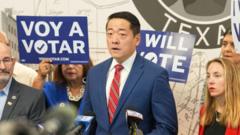The rivalry between California and Texas heats up as redistricting efforts from both states spark a political arms race. With implications for the balance of power in Congress, the outcome could significantly influence the 2026 midterm elections.**
Redistricting Wars: California Takes Aim at Texas' Congressional Map Changes**

Redistricting Wars: California Takes Aim at Texas' Congressional Map Changes**
A fierce political showdown unfolds as California and Texas engage in redistricting battles over congressional seats ahead of the midterm elections.**
Lawmakers in California and Texas, the two largest states in the US with a combined population exceeding 70 million, are embroiled in a contentious political dispute that could reshape the power dynamics in Washington, D.C. Texas has enacted a controversial redistricting plan aimed at gaining five additional congressional seats that are expected to favor Republican candidates. In response, California’s lawmakers took decisive action by voting to redraw its congressional maps to counter the Republican advantage, with the revised boundaries set to be put before voters this November.
The ongoing rivalry between these states is emblematic of a wider political struggle that could soon stretch to other regions as the nation gears up for the midterm elections next year. The conflict erupted in Texas during the summer when the Republican-led legislature unusually opted to adjust congressional districts midway through a decade that typically sees such changes post-census—an action that is likely to enhance Republican representation of the state's congressional delegation.
The Democratic leaders in California promptly retaliated by mapping out their own districts with the goal of increasing their presence in Congress by five seats, effectively aiming to neutralize the GOP's gains in Texas. This political jockeying encapsulates the strategic importance of redistricting amid an upcoming election season where the House of Representatives remains precariously balanced.
Typically, congressional districts are established following the decennial census, designed to reflect population changes. However, the current climate sees both major political parties arguing over mid-decade redrawing, which is increasingly becoming a tactic to manipulate Congressional outcomes based on the shifting demographics and electoral landscapes in both state capitals.
Amidst this backdrop, former President Trump has been vocal in encouraging Republican-governed states to take a proactive stance on redistricting to maintain their grip on Congress. The initial efforts in Texas encountered significant challenges earlier this year when Democratic lawmakers staged a walkout to deny the state legislature a quorum necessary for voting on the controversial map changes. They ultimately returned, leading to a decisive vote that saw the Texas Senate endorse the newly drawn districts.
The legality surrounding the redistricting process is scrutinized under the lens of gerrymandering—a practice employed by both major political parties that, while legal, aims to skew electoral boundaries to secure partisan advantages. Critics have contended that these moves undermine the democratic process by letting politicians dictate their voters through convoluted district layouts.
With Texas pushing forward, California seeks to respond similarly, although the process is slowed due to state laws designed to minimize partisanship in redistricting decisions. Recently, California legislators voted to place future congressional map proposals on the ballot, allowing the public to decide, which could face backlash given the previous arrangement for a non-partisan commission to oversee such matters.
States such as Illinois, New York, New Jersey, and others controlled by Democrats are already contemplating measures to counter Texas’ redistricting actions, while Republican-led states like Indiana and Florida are assessing their own strategies to bolster Republican positions in Washington. With such political maneuvering at play, the redistricting efforts underway could substantially influence the political landscape for the midterms and beyond.





















